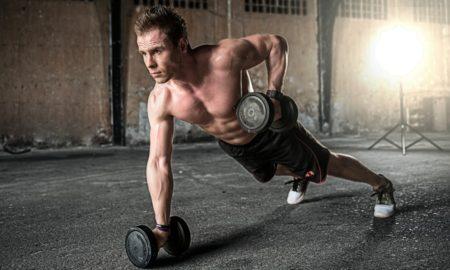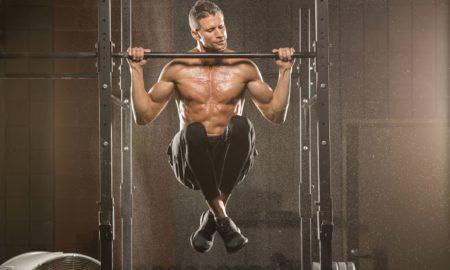As well as my training clients did from the beginning, I eventually gained a conviction’that went all the way down to my toenails’that they should be doing better. I knew that there’s a reason for everything in the universe, including why a person might not be making regular, satisfactory bodybuilding progress, and that the number of possible explanations is far from infinite. All I had to do was further my knowledge of the fundamentals of exercise’intensity, volume and frequency’and then refine their practical application so that my clients would make spectacular and continuous progress. (Spectacular, like all concepts, must be defined contextually. What may be spectacular for a person who has poor genetics, of course, would not be spectacular for someone who has good genetics.)
With a properly conducted Heavy Duty high-intensity program a person grows stronger at every workout, without fail, until he reaches the upper limit of his potential. I shall illustrate my point with a study in contrasts.
A few years ago I had an in-the-gym training client who was a rank beginner, never having lifted a weight in his life. He improved the functional ability of his quadriceps to the point where his performance on the Nautilus leg extension machine went from 170 pounds for seven reps to failure to the entire stack (250 pounds) for 10 reps’and in slightly less than two months! (Unfortunately, he stopped training soon after that due to personal pressures.) Considering the very little actual time he spent in the gym’by any standard, in fact’that’s spectacular progress.
Not long after that I was approached by David Paul, of the Barbarian Brothers acting duo, to supervise his workouts. David is a genetic freak, a bodybuilder whose innate potential for gaining strength and muscle mass is vastly superior to the average.
Here’s the contrast: After close to two decades of training, David, under my personal supervision, reached a high of 33 reps to failure on the Nautilus leg extension machine using the whole stack, while after only two months of training my client, the rank beginner’who appeared to be of average or slightly below average genetics’performed 10 reps to failure with the same stack on the same machine. How much longer would it have been before the beginner matched David’s performance? Probably never. Given his rate of improvement, however, that client would most likely have actualized his strength potential in well under a year. Remember, there’s a relationship between strength and size. Once the client had actualized his strength potential, his size potential would have soon been realized.
Bodybuilders who know nothing of high-intensity anaerobic-exercise stress theory wouldn’t even know where to begin projecting how much time it would take to actualize potential. They don’t think about that issue at all, as much of their time is spent wringing their hands, biting their nails and worrying about whether they’ll ever make any progress. The same goes for the experts of the bodybuilding orthodoxy and the exercise-science establishment. When was the last time you saw them even broach the subject of maximizing potential? They imply that training progress is something to be expected in tiny dribbles, something that comes unpredictably every now and then. That’s because the volume approach represents a wanton assemblage of random, disconnected and contradictory ideas’which, of course, is not a theory and, therefore, cannot serve as a guide for successful action.
The main point is that no matter what your muscular potential, you’ll never actualize it without employing a high-intensity program that limits volume and frequency. As I’ve said on a number of occasions, if NASA can send a man to the moon and bring him back safely, there’s no good reason why we shouldn’t succeed with every one of our missions to the gym here on earth. That should be a cakewalk compared to a moon walk.
Recovery as Healing
Q: Your regular references to the importance of getting rest and recovery between workouts have finally penetrated my thick skull. After rereading several of your articles and reflecting on my frustrating lack of progress in training for up to two hours daily, I finally realize that I’ve been, as you say, ‘chronically, grossly overtraining.’ Now I see that the recovery time is just as important as the workout. I’ve developed an intense interest in the subject of recovery. Can you tell me something more specific about what it actually is?
A: Remember that exercise is a form of stress’and that exercise science is largely the science of stress physiology. The imposition of a high-intensity anaerobic-training stress causes damage at the cellular level. The healing of that damage is recovery, or compensation, and, if the training stress wasn’t grossly excessive, hypertrophy of the muscles, or overcompensation, will follow. (Note, however, that the result of a rest-and-recovery period after chronic gross overtraining wouldn’t be hypertrophy but, one hopes, recovery’that is, healing’just as the result of a recovery period from sunburn wouldn’t be a suntan but healed, normal skin.)
While no one understands the entirety of the recovery-and-healing response, present knowledge reveals that acute inflammation is involved. It’s been suggested by many researchers that delayed-onset muscle soreness is one of the effects of an acute inflammatory process.
The recovery-and-healing phenomenon follows a certain course of events within a specific time, which may vary owing to individual factors. The first is the actual damage resulting from the high-intensity muscle contractions, both concentric and eccentric. The ensuing 24 hours sees an increasing number of white blood cells congregating at the site of the exercise trauma. Simultaneously, lysosomal enzymes, which break down and digest damaged tissue, are released. Then macrophages begin to accumulate, which goes on for up to several days. They aid lysosomal activity and synthesize a variety of chemicals in response to inflammation.
That inflammatory response is thought to cause further damage and may continue for several days beyond the imposition of the training stress. It’s only when the inflammatory responses are complete that the first signs of tissue regeneration are observed.
Keep in mind that the muscle cell must recover, heal and compensate, or build back to normal levels; only then will the process of overcompensation, or growth, begin. In addition, the growth process takes time to complete as well. The principle you should take from that information is as follows: Rest long enough between workouts to allow for completion of both the recovery and growth processes.
How long is that? My observations, along with those of numerous other high-intensity trainers around the country, clearly indicate that it’s at least a week’and longer if an individual has naturally poor recovery ability.
Let’s assume for a minute that there’s such a thing as a ‘sunning’ coach. What if you were a sunning coach with 200 clients? Would you take them all into the intense August sunlight for two hours every day? Of course not. You’d kill some of them. Nevertheless, that’s essentially what exercise scientists who advocate that everyone train with 60 sets six days a week are doing. And the exercise scientists who advocate easy’i.e., submaximal’training days are like a sunning coach who suggests that on certain easy days his charges should run back and forth from the shade into the sun’for hours’to help mitigate the effects of chronic overexposure. Why not just get out of the sun’i.e., stop overtraining’altogether? More on Static Training
Q: First, I’d like to congratulate you for putting out such a wonderful four-tape audio series. I’ve listened to the tapes numerous times, especially tape 2, which I listen to when I drive to the gym. In the booklet that accompanies the tape, you mention static training but don’t say much. I found it fascinating, as I’d never heard anyone suggest that there might be benefit in just holding weights. How does it work?
A: Technically, you’re a bodybuilder, not a weightlifter. As a bodybuilder your primary purpose is not to hoist the heaviest weights possible but to achieve full, high-intensity contractions to induce optimum growth stimulation. While it’s true that you must increase your strength if you want to build bigger muscles, the development of strength is not the final goal. Bodybuilders lift progressively heavier weights as a means of progressively increasing the stress, or intensity, of their workouts’again, a prerequisite for growing progressively larger muscles.
Traditionally, anaerobic, weight-resistance exercise has been thought of as weightlifting; however, the actual lifting of weights is not necessarily the most productive way to train.
Remember that the skeletal muscles all have three levels of strength, or ability. The first is positive strength, which is the ability to actually lift the weight from a position of full muscular extension’as at the bottom, starting position of a curl’to one of full muscular contraction. It’s the weakest of the three levels of functional ability. The second is static strength, or the ability to hold the weight at any given point in the range of motion, such as the fully contracted position. Static strength is considerably greater than positive strength.
The third level of ability is negative strength, and it’s the muscles’ ability to lower weights under full control. Negative strength is by far the greatest of the three levels. Someone who can curl a 100-pound weight for one rep might be able to hold statically, at any given point in the range of motion, a considerably greater weight’120 pounds or more, depending on certain genetic factors’and he or she would be able to lower, negatively, an even greater weight of 140 pounds or more.
Why do positive, static and negative abilities differ so dramatically? The answer comes from the one man who has done truly innovative, meaningful research into specialized aspects of anaerobic resistance exercise; namely, Arthur Jones. The answer is friction. According to Mr. Jones, ‘Internal friction in muscles reduces positive strength and increases negative strength.’ During the lifting of the weight, the muscles must produce enough force to overcome the resistance provided by the weight; but they must also produce enough force to overcome the internal friction. When statically holding and lowering a weight, however, the internal friction becomes increasingly a boon. Rather than hindering you, it helps you.
It’s important to note here that the friction in muscles is not consistent. Muscular friction is increased by a faster speed of contraction and by fatigue. If a trainee’s fresh levels of strength were 100 positive, 140 negative and 120 static, and he exercised to a point at which his positive strength was reduced to zero, his remaining static strength would be 60 and his negative strength would be 120! Read that last sentence again. Why such a difference? Muscular friction is increased by fatigue, and friction makes your positive strength weaker while it makes your static and negative strength stronger.
Recently, I’ve been demonstrating the enormous difference between the three levels of strength to my clients. Not surprisingly, the ratio of the three levels differs among individuals due to genetic factors. One gentleman in particular had static and negative ability that were so much greater than his positive ability, it shocked me more than it did him.
I had him carry a set of Nautilus laterals to positive failure at nine reps. When he reached failure at the ninth rep, I told him to relax momentarily, then attempt one more positive rep with the same weight. He couldn’t budge it. Then I very quickly reached around the machine and placed the pin in the last plate of the weight stack, 250 pounds, whereupon I helped him into the top, contracted position and told him to hold it there as long as possible. It was almost as though he was merely holding his arms out to the sides with no resistance, as he showed no visible strain. In fact, his static strength at that point was so great, he talked to me for more than 10 seconds before finally saying that the weight was beginning to feel heavy.
A few seconds after that I instructed him to begin lowering the weight slowly, in controlled negative fashion. When he stepped out of the machine and saw where the pin was, he was shocked. ‘You mean after failing at nine reps with 170 pounds, I had the static strength to hold 250 pounds immobile for 15 seconds?’ he exclaimed.
‘That’s correct, I replied. ‘But don’t fail to note that once your static strength was no longer available, you still had sufficient negative strength to lower the same weight slowly, under strict muscular control.’
For people who are familiar with Heavy Duty high-intensity training theory, the implications of the above are stunning, with some being obvious and others not. I’m planning more research in this area of exercise science and will keep IRONMAN readers duly apprised. IM




















You must be logged in to post a comment Login